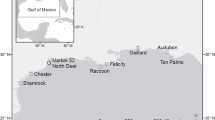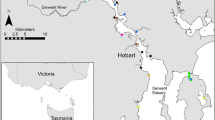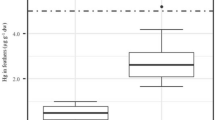Abstract
Mercury (Hg) and selenium (Se) concentrations were determined in feathers of nestling and adult bald eagles (Haliaeetus leucocephalus) in the Great Lakes region, 1985–1989. Relationships between concentrations and two measures of reproduction, productivity and nesting success, were examined. Hg and Se were detected in all feathers analyzed. A maximum concentration of 66 mg/kg Hg was found in adult feathers in the upper peninsula of Michigan. The geometric means of Hg in adult feathers for sample areas were: interior lower peninsula of Michigan, 21 mg/kg; interior upper peninsula of Michigan, 21 mg/kg; Lake Superior, 22 mg/kg; Lakes Michigan and Huron, 20 mg/kg; and Lake Erie, 13 mg/kg. The geometric means of Hg in nestling feathers for sample areas were: interior lower peninsula of Michigan, 8.8 mg/kg; interior upper peninsula of Michigan, 8.1 mg/kg; Lake Superior, 8.7 mg/kg; Lakes Michigan and Huron, 8.0 mg/kg; Lake Erie, 3.7 mg/kg; and Voyageurs National Park, 20 mg/kg. Se concentrations were not significantly different across regions or between adult and nestling feathers, and Se concentrations ranged from 0.8 to 3.2 mg/kg.
No significant relationships between adult or nestling feather concentrations and either measure of reproduction, productivity or nesting success, was found for either Hg or Se. It was concluded that neither Hg nor Se concentrations are currently affecting bald eagle reproduction in the Great Lakes region.
Similar content being viewed by others
References
Anthony RG, Garrett MG, Schuler CA (1993) Environmental contaminants in bald eagles in the Columbia River Estuary. J Wildl Manage 57:10–19
Barr JF (1986) Population dynamics of the common loon (Gavia immer) associated with mercury-contaminated waters in northwestern Ontario. Occasional Paper No 56, Can Wildl Serv, Ottawa, Canada
Berg W, Johnels A, Sjostrand B, Westermark T (1966) Mercury content in feathers of Swedish birds from the past 100 years. Oikos 17:71–83
Best DA, Bowerman WW, Kubiak TJ, Winterstein SR, Postupalsky S, Shieldcastle M (1994) Reproductive impairment of bald eagles along the Great Lakes shorelines of Michigan and Ohio. In: IV world conference on birds of prey and owls, Berlin, Germany
Borg K, Erne K, Hanko E, Wanntrop H (1970) Experimental secondary methyl mercury poisoning in the goshawk (Accipiter gentilis). Environ Pollut 1:91–104
Bowerman WW (1993) Regulation of bald eagle (Haliaeetus leucocephalus) productivity in the Great Lakes Basin: An ecological and toxicological approach. Unpubl PhD dissertation, Michigan State Univ, E Lansing, MI
Braune BM, Gaskin DE (1987) Mercury levels in Bonaparte's gulls (Larus philadephia) during autumn molt in the Quoddy Region, New Brunswick, Canada. Arch Environ Contam Toxicol 16:539–549
Bühler U, Norheim G (1982) The mercury content in feathers of the sparrowhawk Accipiter nisus in Norway. Fuana Norv Ser C Cinclus 5:43–46
Burger J (1993) Metals in avian feathers: Bioindicators of environmental pollution. Rev Environ Toxicol 5:203–311
Eisler R (1985) Selenium hazards to fish, wildlife and invertebrates: A synoptic review. Biol Rep 85(1.10). US Fish and Wildl Serv, Washington, DC
Evans E, Wilson M, Creal W (1991) Assessment of mercury contamination in selected Michigan lakes, 1987–90: Historical trends, environmental correlates, and potential sources. Michigan Dept Nat Resour Staff Rep Surface Water Qual Div, Great Lakes Environ Assessment Section, Water Qual Appraisal Unit, Lansing, MI
Evans E (1993) Mercury and other metals in bald eagle feathers and other tissues from Michigan, nearby areas of Minnesota, Wisconsin, Ohio, Ontario, and Alaska 1985–1989. Michigan Dept Nat Resour Staff Rep Wildl Div, Natural Heritage Program, Lansing, MI
Fimreite N, Karstad L (1971) Effects of dietary methylmercury on red-tailed hawks. J Wildl Manage 35:293–300
Fimreite N (1979) Accumulation and effects of mercury on birds. In JO Nriagu (ed), The biogeochemistry of mercury in the environment. Elsevier/North-Holland, Amsterdam, pp 602–627
Frenzel RW (1984) Environmental contaminants and ecology of bald eagles in southcentral Oregon. Unpubl PhD thesis, Oreg St Univ, Corvallis, OR
Hakkinen I, Hasanen E (1980) Mercury in eggs and nestling of the osprey, Pandion haliaetus, in Finland and its bioaccumulation from fish. Annu Zoologia Fennici 17:131–139
Heinz GH (1979) Methylmercury: Reproductive and behavioral effects on three generations of mallard ducks. J Wildl Manage 42:394–401
Helander B, Olsson M, Reutergårdh L (1982) Residue levels of organochlorine and mercury compounds in unhatched eggs and the relationship to breeding success in white-tailed sea eagles Haliaeetus albicilla in Sweden. Holarctic Ecol 5:349–366
Hoffman DJ, Ohlendorf HM, Aldrich TW (1988) Selenium teratogenicity in natural populations of aquatic birds in central California. Arch Environ Contam Toxicol 7:519–525
Honda K, Marcovecchio J, Kan S, Tatsukawas R, Ogi H (1990) Metal concentrations in pelagic seabirds from the north Pacific Ocean. Arch Environ Contam Toxicol 19:704–711
Jenkins D (1980) Biological monitoring of toxic trace metals. Vol 2, Toxic trace metals in plants and animals of the world. EPA-600/3–80–091. US Environ Protection Agency, Las Vegas, NV
Johnson M (1987) Trace element loadings to sediments of fourteen Ontario lakes and correlations with concentrations in fish. Can J Fish Aquat Sci 44:3–13
Koivusaari J, Nuuja I, Palokangus R, Finnlund M (1980) Relationships between productivity, eggshell thickness and pollutant contents of addled eggs in the population of white-tailed eagles Haliaëtus albicilla L in Finland during 1969–1978. Environ Pollut (Ser A) 23:41–52
MDNR (1981) Quality assurance for water and sediment sampling. Publ No 3730–0028. Environ Protection Bureau, Michigan Dept Nat Resour, Lansing, MI
— (1987) Analytical methods for environmental samples. Environ Protection Bureau, Michigan Dept Nat Resour, Lansing, MI
Miller RG (1981) Simultaneous statistical inference. Springer-Verlag, NY
Norheim G, Froslic A (1978) The degree of methylation and organ distribution in some birds of prey in Norway. Acta Pharmacol Toxicol 43:196–204
Norton S, Hess C, Davis R (1981) Rates of accumulation of heavy metals in pre- and post-European sediments in New England lakes. In S Eisenreich (ed) Atmospheric pollutants in natural waters, Ann Arbor Science Publishers, Ann Arbor, MI
Nriagu JO (1990) Global metal pollution: Poisoning the biosphere? Environ 32(7):7–11, 28–33
Ohlendorf H, Hoffman D, Saiki M, Aldrich T (1986) Embryonic mortality and abnormalities of aquatic birds: apparent impacts of selenium from irrigation drainwater. Sci Tot Environ 52:49–63
Postupalsky S (1974) Raptor reproductive success: Some problems with methods, criteria, and terminology. In FN Hamerstrom, Jr, BE Harrell, RR Ohlendorff (eds), Management of raptors. Proceed Conf Raptor Conserv Techn, Fort Collins, CO, pp 21–31
SAS Institute Inc (1991) SAS/STAT version 6.06. Carey, NC
Scanlon PF, Oderwald RG, Dietrick TJ, Coggin JL (1980) Heavy metal concentrations in feathers of ruffed grouse shot by Virginia hunters. Bull Environ Contam Toxicol 25:947–949
Tejning S (1967) Biological effects of methyl mercury diacyaniamide-treated grain in the domestic fowl Gallus gallus L. Oikos Suppl 8:1–116
Westermark T, Odsjo T, Johnels A (1975) Mercury content of bird feathers before and after Swedish ban on alkyl mercury in agriculture. Ambio 4:87–92
Wiemeyer SN, Lamont TG, Bunck CM, Sindelar CR, Gramlich FJ, Fraser JD, Byrd MA (1984) Organochlorine pesticide, polychlorobiphenyl, and mercury residues in bald eagle eggs—1969–79—and their relationships to shell thinning and reproduction. Arch Environ Contam Toxicol 13:529–549
Wong T, Nriagu J, Coker R (1984) Atmospheric input of heavy metals chronicled in lake sediments of the Algonquin Provincial Park, Ontario, Canada. Chem Geol 44:187–201
Author information
Authors and Affiliations
Rights and permissions
About this article
Cite this article
Bowerman, W.W., Evans, E.D., Giesy, J.P. et al. Using feathers to assess risk of mercury and selenium to bald eagle reproduction in the Great Lakes region. Arch. Environ. Contam. Toxicol. 27, 294–298 (1994). https://doi.org/10.1007/BF00213162
Received:
Revised:
Issue Date:
DOI: https://doi.org/10.1007/BF00213162




